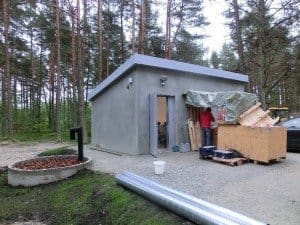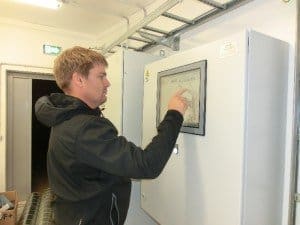Official Opening of New Smart Vacuum System in Estonia
 Merko, the leading construction company in Estonia has finished construction in Vääna-Jõesuu of Estonia’s second vacuum sewerage system – Flovac’s first system was completed last year in Leppneeme and has performed better than expectations for both the community and the operators.
Merko, the leading construction company in Estonia has finished construction in Vääna-Jõesuu of Estonia’s second vacuum sewerage system – Flovac’s first system was completed last year in Leppneeme and has performed better than expectations for both the community and the operators.
Both systems were of a similar size about 650 people and near the coast where septic tanks were causing environmental problems.
According to Valdo Liiv of OÜ Strantum, the company that commissioned the work, the use of vacuum sewerage systems in outdoor piping solutions is unjustifiably uncommon in Estonia. “When the work was ordered, the main reason for utilizing a vacuum-based system was the low costs of construction and maintenance, but now that the first customers are hooked up to the system, we also see the system is very convenient to use, particularly with respect to monitoring customers.”
“The work in Vääna-Jõesuu progressed very smoothly and quickly. All four phases of the project were completed before the contractual deadline. We have therefore been able to minimize inconveniences associated with construction work for both residents and holidaymakers in the area,” said Merko Ehitus Eesti AS project manager Peeter Laidma.
 “A vacuum station and waste water pumping station were built in the Puraviku tee and Nõmmerohu tee area, as well as 3.8 km of drinking water piping and 4.1 km of sewerage piping, including nearly 3.6 km of vacuum sewerage piping. The benefit of vacuum sewerage is efficiency – the sewerage pumping station does not have to pump excess water, since the watertight vacuum sewerage system takes in significantly less water from rainfall, snowmelt, leaking pipes and wells than ordinary sewerage systems. The vacuum sewerage tanks are waterproof and the tanks’ lids are 10-20 cm above the ground to prevent rainwater from leaking in from the lid,” Laidma explained.
“A vacuum station and waste water pumping station were built in the Puraviku tee and Nõmmerohu tee area, as well as 3.8 km of drinking water piping and 4.1 km of sewerage piping, including nearly 3.6 km of vacuum sewerage piping. The benefit of vacuum sewerage is efficiency – the sewerage pumping station does not have to pump excess water, since the watertight vacuum sewerage system takes in significantly less water from rainfall, snowmelt, leaking pipes and wells than ordinary sewerage systems. The vacuum sewerage tanks are waterproof and the tanks’ lids are 10-20 cm above the ground to prevent rainwater from leaking in from the lid,” Laidma explained.
“Additionally, each tank is equipped with sensors to monitor the flow of each client’s waste water. Any increase in flow is automatically picked up by the sensor and notifies a maintenance technician. Ordinary sewerage systems do not have this monitoring capability and major leaks are usually only discovered by chance or when some other problem is being addressed,” added Laidma.
The construction work was carried out by AS Merko Ehitus Eesti and AS Merko Infra, which also built Estonia’s thus far only vacuum sewerage piping system, in the village of Leppneeme in Viimsi municipality.
the official opening was attended by Flovac’s Regional manager Mr Ralph Grüschow

